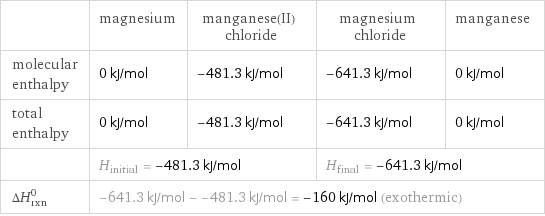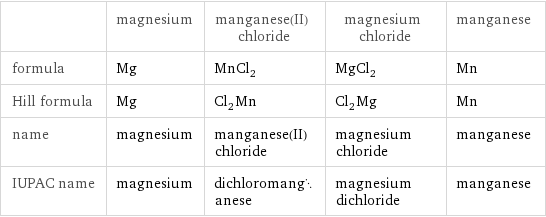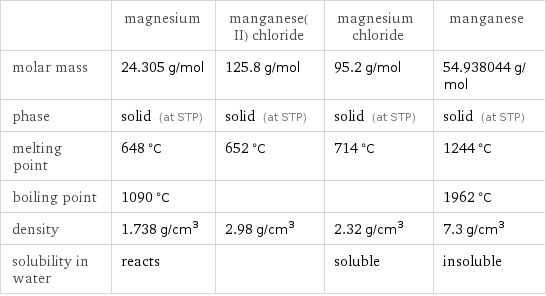Input interpretation

Mg magnesium + MnCl_2 manganese(II) chloride ⟶ MgCl_2 magnesium chloride + Mn manganese
Balanced equation

Balance the chemical equation algebraically: Mg + MnCl_2 ⟶ MgCl_2 + Mn Add stoichiometric coefficients, c_i, to the reactants and products: c_1 Mg + c_2 MnCl_2 ⟶ c_3 MgCl_2 + c_4 Mn Set the number of atoms in the reactants equal to the number of atoms in the products for Mg, Cl and Mn: Mg: | c_1 = c_3 Cl: | 2 c_2 = 2 c_3 Mn: | c_2 = c_4 Since the coefficients are relative quantities and underdetermined, choose a coefficient to set arbitrarily. To keep the coefficients small, the arbitrary value is ordinarily one. For instance, set c_1 = 1 and solve the system of equations for the remaining coefficients: c_1 = 1 c_2 = 1 c_3 = 1 c_4 = 1 Substitute the coefficients into the chemical reaction to obtain the balanced equation: Answer: | | Mg + MnCl_2 ⟶ MgCl_2 + Mn
Structures

+ ⟶ +
Names

magnesium + manganese(II) chloride ⟶ magnesium chloride + manganese
Reaction thermodynamics
Enthalpy

| magnesium | manganese(II) chloride | magnesium chloride | manganese molecular enthalpy | 0 kJ/mol | -481.3 kJ/mol | -641.3 kJ/mol | 0 kJ/mol total enthalpy | 0 kJ/mol | -481.3 kJ/mol | -641.3 kJ/mol | 0 kJ/mol | H_initial = -481.3 kJ/mol | | H_final = -641.3 kJ/mol | ΔH_rxn^0 | -641.3 kJ/mol - -481.3 kJ/mol = -160 kJ/mol (exothermic) | | |
Equilibrium constant
![Construct the equilibrium constant, K, expression for: Mg + MnCl_2 ⟶ MgCl_2 + Mn Plan: • Balance the chemical equation. • Determine the stoichiometric numbers. • Assemble the activity expression for each chemical species. • Use the activity expressions to build the equilibrium constant expression. Write the balanced chemical equation: Mg + MnCl_2 ⟶ MgCl_2 + Mn Assign stoichiometric numbers, ν_i, using the stoichiometric coefficients, c_i, from the balanced chemical equation in the following manner: ν_i = -c_i for reactants and ν_i = c_i for products: chemical species | c_i | ν_i Mg | 1 | -1 MnCl_2 | 1 | -1 MgCl_2 | 1 | 1 Mn | 1 | 1 Assemble the activity expressions accounting for the state of matter and ν_i: chemical species | c_i | ν_i | activity expression Mg | 1 | -1 | ([Mg])^(-1) MnCl_2 | 1 | -1 | ([MnCl2])^(-1) MgCl_2 | 1 | 1 | [MgCl2] Mn | 1 | 1 | [Mn] The equilibrium constant symbol in the concentration basis is: K_c Mulitply the activity expressions to arrive at the K_c expression: Answer: | | K_c = ([Mg])^(-1) ([MnCl2])^(-1) [MgCl2] [Mn] = ([MgCl2] [Mn])/([Mg] [MnCl2])](../image_source/3c71024f77f536d98db70c88b56280d9.png)
Construct the equilibrium constant, K, expression for: Mg + MnCl_2 ⟶ MgCl_2 + Mn Plan: • Balance the chemical equation. • Determine the stoichiometric numbers. • Assemble the activity expression for each chemical species. • Use the activity expressions to build the equilibrium constant expression. Write the balanced chemical equation: Mg + MnCl_2 ⟶ MgCl_2 + Mn Assign stoichiometric numbers, ν_i, using the stoichiometric coefficients, c_i, from the balanced chemical equation in the following manner: ν_i = -c_i for reactants and ν_i = c_i for products: chemical species | c_i | ν_i Mg | 1 | -1 MnCl_2 | 1 | -1 MgCl_2 | 1 | 1 Mn | 1 | 1 Assemble the activity expressions accounting for the state of matter and ν_i: chemical species | c_i | ν_i | activity expression Mg | 1 | -1 | ([Mg])^(-1) MnCl_2 | 1 | -1 | ([MnCl2])^(-1) MgCl_2 | 1 | 1 | [MgCl2] Mn | 1 | 1 | [Mn] The equilibrium constant symbol in the concentration basis is: K_c Mulitply the activity expressions to arrive at the K_c expression: Answer: | | K_c = ([Mg])^(-1) ([MnCl2])^(-1) [MgCl2] [Mn] = ([MgCl2] [Mn])/([Mg] [MnCl2])
Rate of reaction
![Construct the rate of reaction expression for: Mg + MnCl_2 ⟶ MgCl_2 + Mn Plan: • Balance the chemical equation. • Determine the stoichiometric numbers. • Assemble the rate term for each chemical species. • Write the rate of reaction expression. Write the balanced chemical equation: Mg + MnCl_2 ⟶ MgCl_2 + Mn Assign stoichiometric numbers, ν_i, using the stoichiometric coefficients, c_i, from the balanced chemical equation in the following manner: ν_i = -c_i for reactants and ν_i = c_i for products: chemical species | c_i | ν_i Mg | 1 | -1 MnCl_2 | 1 | -1 MgCl_2 | 1 | 1 Mn | 1 | 1 The rate term for each chemical species, B_i, is 1/ν_i(Δ[B_i])/(Δt) where [B_i] is the amount concentration and t is time: chemical species | c_i | ν_i | rate term Mg | 1 | -1 | -(Δ[Mg])/(Δt) MnCl_2 | 1 | -1 | -(Δ[MnCl2])/(Δt) MgCl_2 | 1 | 1 | (Δ[MgCl2])/(Δt) Mn | 1 | 1 | (Δ[Mn])/(Δt) (for infinitesimal rate of change, replace Δ with d) Set the rate terms equal to each other to arrive at the rate expression: Answer: | | rate = -(Δ[Mg])/(Δt) = -(Δ[MnCl2])/(Δt) = (Δ[MgCl2])/(Δt) = (Δ[Mn])/(Δt) (assuming constant volume and no accumulation of intermediates or side products)](../image_source/4d9ebbb57c10913640b1b8e5faf3d09c.png)
Construct the rate of reaction expression for: Mg + MnCl_2 ⟶ MgCl_2 + Mn Plan: • Balance the chemical equation. • Determine the stoichiometric numbers. • Assemble the rate term for each chemical species. • Write the rate of reaction expression. Write the balanced chemical equation: Mg + MnCl_2 ⟶ MgCl_2 + Mn Assign stoichiometric numbers, ν_i, using the stoichiometric coefficients, c_i, from the balanced chemical equation in the following manner: ν_i = -c_i for reactants and ν_i = c_i for products: chemical species | c_i | ν_i Mg | 1 | -1 MnCl_2 | 1 | -1 MgCl_2 | 1 | 1 Mn | 1 | 1 The rate term for each chemical species, B_i, is 1/ν_i(Δ[B_i])/(Δt) where [B_i] is the amount concentration and t is time: chemical species | c_i | ν_i | rate term Mg | 1 | -1 | -(Δ[Mg])/(Δt) MnCl_2 | 1 | -1 | -(Δ[MnCl2])/(Δt) MgCl_2 | 1 | 1 | (Δ[MgCl2])/(Δt) Mn | 1 | 1 | (Δ[Mn])/(Δt) (for infinitesimal rate of change, replace Δ with d) Set the rate terms equal to each other to arrive at the rate expression: Answer: | | rate = -(Δ[Mg])/(Δt) = -(Δ[MnCl2])/(Δt) = (Δ[MgCl2])/(Δt) = (Δ[Mn])/(Δt) (assuming constant volume and no accumulation of intermediates or side products)
Chemical names and formulas

| magnesium | manganese(II) chloride | magnesium chloride | manganese formula | Mg | MnCl_2 | MgCl_2 | Mn Hill formula | Mg | Cl_2Mn | Cl_2Mg | Mn name | magnesium | manganese(II) chloride | magnesium chloride | manganese IUPAC name | magnesium | dichloromanganese | magnesium dichloride | manganese
Substance properties

| magnesium | manganese(II) chloride | magnesium chloride | manganese molar mass | 24.305 g/mol | 125.8 g/mol | 95.2 g/mol | 54.938044 g/mol phase | solid (at STP) | solid (at STP) | solid (at STP) | solid (at STP) melting point | 648 °C | 652 °C | 714 °C | 1244 °C boiling point | 1090 °C | | | 1962 °C density | 1.738 g/cm^3 | 2.98 g/cm^3 | 2.32 g/cm^3 | 7.3 g/cm^3 solubility in water | reacts | | soluble | insoluble
Units
